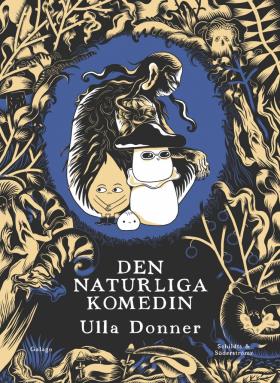
Den naturliga komedin
(The Natural Comedy)
by Ulla Donner
reviewed by Darcy Hurford
Autumn arrives with a forceful breath out and millions of leaves fly up into the skies. They could almost be the opening words of a children’s book. Over the next pages though, we see one small leaf with pointy black shoes become detached from the crowd, despite repeating its mantra (‘I welcome positive energy in my life. I’m unique and self-confident. I deserve and am worth all the good things in life’) and be blown far away, landing on top of a sunglasses-wearing white bolete mushroom with a black hat and frilly collar. The birch leaf, Björk, is determined to somehow still make its way to the big leaf party, as planned. The mushroom, Candy, has just been dumped by Pierre, who has run off with ‘some basic chanterelle’. After some persuading, Candy agrees to help Björk find the way back to the other leaves and they set off towards Candy’s childhood paradise.
Except – paradise is lost. Humans have destroyed the forest. A pinecone tips them off as to Candy’s parents’ whereabouts. Soon they encounter Gun, a giant female creature who seems to have lost her marbles (yet gives Björk a seed to carry) and continue on their way. En route they encounter a cult leader fungus called Kombucha, talking trees, a depressed black trumpet mushroom – and Pierre. In the end, Björk and Candy go the way of all leaves and fungi, but it’s a great journey.
Quotes or paraphrases from all three parts of Dante’s Divine Comedy appear here and Donner has listed them at the end, Gun is allegorical, while Candy is a somewhat crabby Virgil to Björk’s Dante. The references are made lightly though: a gently swaying backdrop rather than a rigid framework.
This is Donner’s third book. While her previous two – Spleenish (2017) and Skiten (2019) were both set in a recognizable modern reality, albeit with satirical features, The Natural Comedy is set is a fictive world where the characters have human features. The images are more elaborate and worked out in more detail than in previous books, yet still move the story along and add further layers of meaning. The result is beautiful to look at, with a palette entirely consisting of yellow, black and dark blue, and images that reveal more and more every time you return to them.
The story is more complex, too. Spleenish and Skiten were by no means lacking in depth or humour, it’s just that Donner has ramped it up a notch this time. Possibly several notches. This is a story you can enjoy on so many levels. It’s about the destruction of the environment – this might just be a standard stretch of Nordic forest, but from the point of view of the mushrooms, its destruction is an apocalypse in its own way just as much as melting ice caps, microplastics and greenhouse gases are elsewhere. It’s also about the cycle of birth and death. And it’s also about how all the positivity mantras in the world can’t save you from impending disaster.
If you read Tove Jansson’s Moomin stories and keep your eyes off the pictures, it’s easy to briefly forget the characters are trolls, fillyjonks or hemulens that mainly live on jam, as they speak and interact and behave so very similarly to people you know. The same happens in The Natural Comedy: mushrooms snipe about eyewear, drinking problems or mindfulness, leaves complain about crowds and it’s part of the humour, but that’s also the sound of human conversations being played back.
And on the subject of mushrooms, they’re something else rather Finnish about this story, universal though it is. For anyone used to a UK fungus frame of reference (approximately: button mushrooms in the supermarket, red-and-white spotted toadstools of fairy tales and black mould in the bathroom), the popularity of mushroom-picking in Finland comes as a surprise. Market stalls sell them, people tend to know names of mushrooms, and are more likely to post their haul on social media, and this is reflected in the many kinds of fungus life appearing in this book. At the same time, the subjects of the book are universal in appeal. A perfect book for autumn, then, but readable all year round.

Den naturliga komedin
Galago / Schildts &Söderströms, Finland, 2023.
120 pages.
Foreign Rights: Helsinki Literary Agency.
Ulla Donner is an illustrator and comic artist. Her debut book, Spleenish, won the debutant prize of Finland’s Swedish Writers’ Association and was nominated for Sarjakuva-Finlandia, the Finlandia prize for comic books, in 2017. Skiten, her second book, won the Sarjakuva-Finlandia in 2019.
